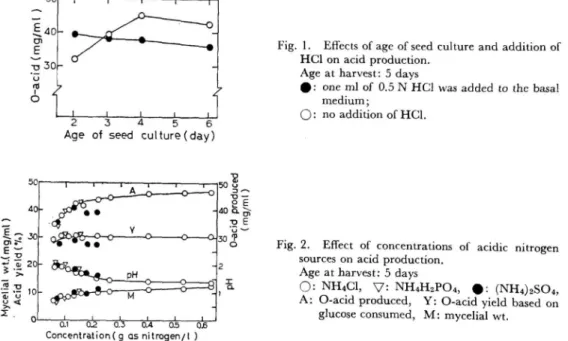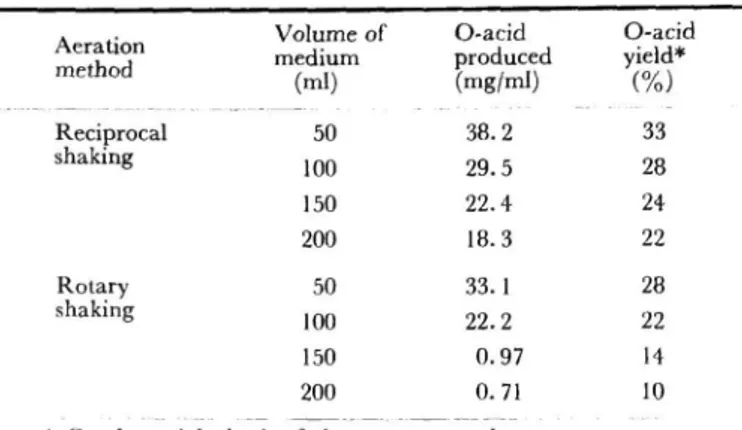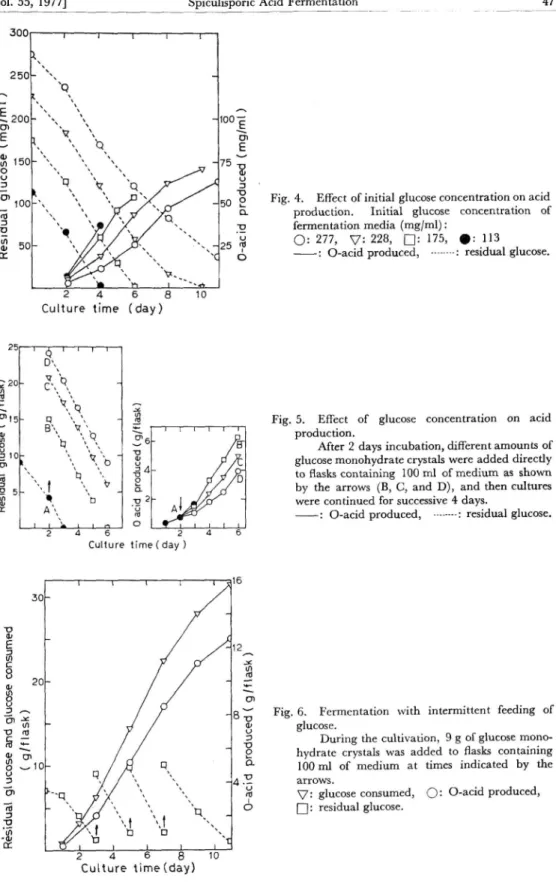Vol.55, 1977] Spiculisporic Acid Fermentation 43
[J. Ferment. Technol., Vol.55, No.1, p. 43•`49, 1977]
Factors Affecting the Production of the Open-ring Acid of
Spiculisporic Acid by Penicillium spiculisporum
TAKESHI TABUCHI, ISEI NAKAMURA, ETSUKO HIGASHI*,
and HIDEYUKI KOBAYASHI
Institute of Applied Biochemistry, The University of Tsukuba, Ibaraki-ken, 300-31 and *Faculty of Agriculture, Tokyo University of Education, Komaba, Meguro-ku, Tokyo
The optimum conditions in shake culture for the production of the open-ring acid of spiculisporic acid by Penicillium spiculisporum No.10-1 were examined. The best growth of the strain was observed at 36•KC, but the best acid production was at 30•KC. The optimum pH for the acid production was extremely low, 2 or below. Either higher
concentrations of glucose or lower rates of aeration led to a decrease in acid yield with formation of considerable amounts of ethanol. Intermittent feeding of glucose proved acid production. The amounts of the acid accumulated in the culture broth reached more than 110g per / after 10 days; the yield of the acid amounted to about 40% on the weight basis of glucose consumed, this value corresponding to more than 60% of carbon recovery.
The preceding paper1) described that Penicillium spiculisporum Lehman No. 10-1
accumulated large amounts of needle-like crystals in culture broth. The precipitated
crystals were identified as 4-hydroxy-4,5-dicarboxypentadecanoic acid, the open-ring
acid (O-acid) of spiculisporic acid2)3) (S-acid), while the culture broth did not contain
S-acid itself. This paper describes experiments designed to determine factors leading to
maximal production of the acid.
Materials and Methods
Microorganism P. spiculisporum No.10-1 used in this study was maintained on sterilized rice, as described in the preceding paper.1)
Cultural conditions Unless otherwise indicated, the composition of the basal medium was as follows: glucose monohydrate (commercial source), 110g; NH4CI, 1g; KH2PO4, 1g; MgSO4•E7H2O, 0.5g; corn steep liquor, 1g; and tap water to make 1l. To prepare seed cultures, 5 to 10 grains of rice on which the strain had grown were first inoculated into 100ml of the basal medium contained in 500-ml Sakaguchi flasks, and the cultures were incubated at 30•KC for 3 to 4 days on a reciprocal shaker at 120 oscillations per min with an amplitude of 7cm. Five ml of the seed culture was transferred into fermentation media (100ml) in 500-ml Sakaguchi flasks which were shaken on the reciprocal shaker at 30•KC unless otherwise indicated. A rotary shaker (200rpm) was also used in an experiment on aeration efficiency.
Determination of O-acid and S-acid Neither volatile nor non-volatile acids were detectable other than O-acid in the usual culture broth, although a large amount of gluconic acid was detected when excess CaCO3 was added to the basal medium. The amount of O-acid produced, therefore, was estimated from the titrable acidity of the culture broth.
Since O-acid accumulated in the culture broth as a precipitate was practically insoluble in water at 30•KC,1) the whole of the culture broth contained in a flask was titrated directly with 2N NaOH to the phenol-phthalein end point. In some cases, 5 or 10ml of the culture broth was taken with a pipet conveniently broadened at the tip, and titrated with 0.1N NaOH. From these titers, amounts of O-acid were estimated: 1ml of 0.1 and 2N NaOH solution correspond to 11.5 and 230mg of O-acid, respectively.
[J. Ferment. Technol .,
Other analytical methods Glucose was determined by a modified Somogyi's method,4) and ex-pressed as anhydrous glucose. To determine the dry weight of mycelia, the culture broth neutralized with alkali was filtered through filter paper and the remaining mycelia were washed with hot water, dried at 90•KC for 2 days, and weighed. To determine alcohol content, the culture broth neutralized with alkali was distilled until one-half of the original volume was collected, and ethanol in the distillate was determined by the method of dichromate oxidation.5)
Results
Effect of age of seed culture Preliminary experiments suggested that O-acid was accumulated markedly at a low medium pH. An experiment was carried out to determine the effects of age of seed culture and of addition of HCl to the basal medium on acid production. The results are shown in Fig. 1. When the youngest seed culture was used, the addition of HCl to the basal medium gave an increase in the amount of O-acid, but the best result was obtained with 4 day-old seed cultures and basal medium without HCl. Accordingly, there was no need to acidify the basal medium initially, because the pH of medium could be rapidly lowered by use of acidic nitrogen sources.
Effect of nitrogen sources The type of nitrogen source exerted a great effect on acid production. Better acid production was obtained with acidic nitrogen sources such as NH4Cl, NH4H2PO4, and (NH4)2SO4. Figure 2 shows the effect of concentration of these nitrogen sources on acid production. By use of these nitrogen sources the pH of the culture medium was lowered to below 2. When NH4Cl, for example, was used at a concentration of 0.02% (0.05g as nitrogen per 1), a good yield of acid was obtained, although the fermentation rate was slightly low. When the concentration of NH4Cl was increased ten-fold (0.2%), the fermentation result was hardly affected.
On the other hand, NH4NO3, NaNO3, and urea as nitrogen sources resulted in low acid yields, as shown in Table 1. The final pH of culture media ranged from 2.5 to 5.3. The growth of fungus (dry weight of mycelia) corresponded to the nitrogen content of the
Fig. 1. Effects of age of seed culture and addition of HCl on acid production.
Age at harvest: 5 days
f: one ml of 0.5N HCl was added to the basal medium; •œ
: no addition of HCl.
Fig. 2. Effect of concentrations of acidic nitrogen sources on acid production.
Age at harvest: 5 days •›
: NH4Cl, •¤: NH4H2PO4, •œ: (NH4)2SO4 , A
: O-acid produced, Y: O-acid yield based on glucose consumed, M: mycelial wt.
Vol.55, 1977] Spiculisporic Acid Fermentation 45
Table 1. Effect of neutral and alkaline nitrogen sources on acid production.
* On the weight basis of glucose consumed . Age at harvest: 5 days.
medium.
Mineral requirements Phosphate deficiency, if not severe, frequently improves product accumulation in several fungal fermentations.6) The effect of phosphate con-centration on acid production was examined. When KH2PO4 was added to the basal medium at concentrations of 0, 0.1, 0.2, 0.5, and 1.0g per l, the amount of O-acid produced after 5 days was 31.1, 38.2, 40.1, 41.9, and 43.4mg per ml, respectively. Phosphate con-centration affected the rate of fermentation rather than the yield. In every case the yield was almost the same, about 35%.
A similar effect was also observed with MgSO4: when MgSO4.7H2O was used at concentrations of 0, 0.1, 0.2, and 1.0 g per 1, the amount of O-acid produced after 5 days was 25.1, 39.5, 40.2, and 42.2mg per ml, respectively. Kleinzeller7) described that a higher salt concentration brought about an increase of fat content in some microorganisms. By the addition of 2% of NaCl, the rate of O-acid production decreased to about three-quarters of that of the control, although the addition of 1% NaCl did not affect the pro-duction of O-acid.
Table 2 shows the effect of addition of corn steep liquor on acid production. The ad-dition of a small amount (0.5g per 1) seemed to slightly accelerate acid production.
Table 2. Effect of corn steep liquor on acid production.
* On the weight basis of glucose consumed . Age at harvest: 4 days.
Table 3. Effect of aeration on acid production.
* On the weight basis of glucose consumed .
Effect of aeration Aeration was also an important factor in this fermentation. Two types of shake culture were conducted: in Sakaguchi flasks on a reciprocal shaker, and 300-ml Erlenmeyer flasks on a rotary shaker. Different volumes of the medium were introduced into the flasks, since the rate of aeration in fermentation was considered to be a function of the volume of medium. As Table 3 shows, acid yield and fermentation rate increased with decrease in volume of medium. Under the least aerobic conditions (200 ml of medium in an Erlenmeyer flask on the rotary shaker) the ethanol content of the culture broth reached 3% (w/v).
Effect of temperature Shake culture was carried out at different temperatures. As Fig. 3 shows, the best growth was observed at 36•KC. The best acid production, however, was observed at 30•KC.
Effect of glucose concentration Figure 4 shows the effect of initial concentration of glucose on acid production. An increase in the initial concentration of glucose caused little change in the rate of sugar consumption.
In the experiments shown in Fig. 5, the organism was grown in several flasks, each initially containing 10g of glucose monohydrate. After incubation for 2 days, different amounts of glucose monohydrate were added directly to each flask. The figure indicates that glucose concentrations above 10% caused little change in the rate of sugar consumption, but inhibited acid production and led to the production of considerable amounts of ethanol. After the concentration of glucose had dropped to below 10%, the acid production occured normally in every case.
Fig. 3. Effect of temperature on growth and acid production.
Age at harvest: 5 days
Vol.55, 1977] Spiculisporic Acid Fermentation 47
Fig. 4. Effect of initial glucose concentration on acid production. Initial glucose concentration of fermentation media (mg/ml): •›
: 277, •¤:228, • : 175, •œ113
•c•c O-acid produced, •c•c: residual glucose.
Fig. 5. Effect of glucose concentration on acid production.
After 2 days incubation, different amounts of glucose monohydrate crystals were added directly
to flasks containing 100ml of medium as shown by the arrows (B, C, and D), and then cultures
were continued for successive 4 days. •c•c : O-acid produced, •c•c: residual glucose.
Fig. 6. Fermentation with intermittent feeding of glucose.
During the cultivation, 9g of glucose hydrate crystals was added to flasks containing
100ml of medium at times indicated by the arrows. •¤
: glucose consumed, •›: O-acid produced, • : residual glucose.
Intermittent feeding of glucose To elevate the concentration of the acid in culture broth, glucose was intermittently fed to culture flasks. As shown graphically in Fig. 6, the fermentation was started with the medium at a glucose concentration of 7.2%. After incubation for 3 days, and subsequently at 2-day intervals, 9g of glucose monohydrate crystals was added directly to each flask, as indicated by the arrows in the figure. Cultures were analyzed after incubation for different times and the analytical results were expressed as g per flask. The initial high rate of acid production was maintained for about 10 days. The amount of acid reached more than 12g per flask, corresponding to more than 110g per l of the culture broth. This high value may be ascribable to the fact that the product is practically insoluble in water,1) that is, product inhibition is probably negligible.
Discussion
Fat production from glucose by fungi is favored by a high concentration of glucose, a low concentration of nitrogen source, and a neutral or slightly alkaline solution.6) These optimal conditions for fat production, however, differed from those for the production of O-acid by P. spiculisporum No.10-1. In O-acid fermentation higher sugar concentrations led to low acid yields and ethanol formation. Nitrogen concentration hardly affected acid production. Highly acidic conditions (below pH2) favored acid production, a feature similar to that of citric acid fermentation by Aspergillus niger, itaconic acid by A. terreus, and kojic acid by A. oryzae.6)
Concerning microbial fat production from carbohydrates, Rippel8) described that maximal fat synthesis, "fat coefficient", was calculated as 15g of fat per 100g of carbo-hydrate utilized. The actual coefficients reported for fungi are in the range of 5 to 15. The amounts of O-acid accumulated in culture broth reached more than 110g per l and the yield of the acid was about 40% on the weight basis of glucose consumed, this value cor-responding to more than 60% of carbon recovery. The content of oxygen in the acid is lower than in glucose; that is, the heat of combustion of the acid is higher than that of glucose. Thus, significant quantities of glucose must be oxidized to supply the necessary energy of conversion. The carbon recovery must, therefore, be close to the theoretical value, though this is unknown.
Microbial utilization of n-alkanes is one of the most interesting projects in fermentation technology at present. Previously, we found that a variety of yeasts are capable of pro-ducing citrate and threo-Ds-isocitrate not only from glucose9) but also from petrochemicals such as n-alkanes and acetate.10,11) Candida lipolytica was found to produce citrate in yields of 140 to 150% from n-alkanes.12) The theoretical yield of citrate from n-alkanes was calculated at 225% from the proposed pathways of citrate production from even-13) and odd-carbon14) n-alkanes. If there is a future shortage of petroleum, the present fermentation might be of interest as a means of producing a derivative of n-alkanes from carbohydrate.
References
1) Tabuchi, T., Nakamura, I., Kobayashi, T.: J. Ferment. Technol., 55, 37 (1977).
2) Clutterbuck, P.W., Raistrick, H., Rintoul, M. L.: Phil. Trans. Roy. London, B220, 301 (1931). 3) Asano, M., Kameda, Y.: J. Pharm. Soc. Japan,
61, 80 (1941).
4) Kobayashi, T., Tabuchi, T.: J. Agr. Chem. Soc.
Japan, 28, 171 (1954).
5) Johnson, M.J.: Ind. Eng. Chem., Anal. Ed., 4, 20 (1932).
6) Prescott, S.C., Dunn, C.G.: Industrial biology, 3rd Ed., McGraw-Hill Book Co. Inc.,
New York (1969).
Vol.55, 1977] Spiculisporic Acid Fermentation 49 8) Rippel, A.: Arch. Mikrobiol., 11, 271 (1940).
9) Tabuchi, T., Tanaka, M., Abe, M.: J. Agr. Chem. Soc. Japan, 42, 440 (1968).
10) Abe, M., Tabuchi, T.: Agr. Biol. Chem., 32, 329 (1968).
11) Abe, M., Tabuchi, T., Tanaka, M.: J. Agr. Chem. Soc. Japan, 44, 493 (1970).
12) Tabuchi, T., Tanaka, M., Tahara, Y., Abe, M.:
J. Agr. Chem. Soc. Japan, 44, 562 (1970). 13) Tabuchi, T., Hara, S.: J. Agr. Chem. Soc.
Japan, 48, 417 (1974).
14) Tabuchi, T., Serizawa, N.: Agr. Biol. Chem., 39, 1055 (1975).


